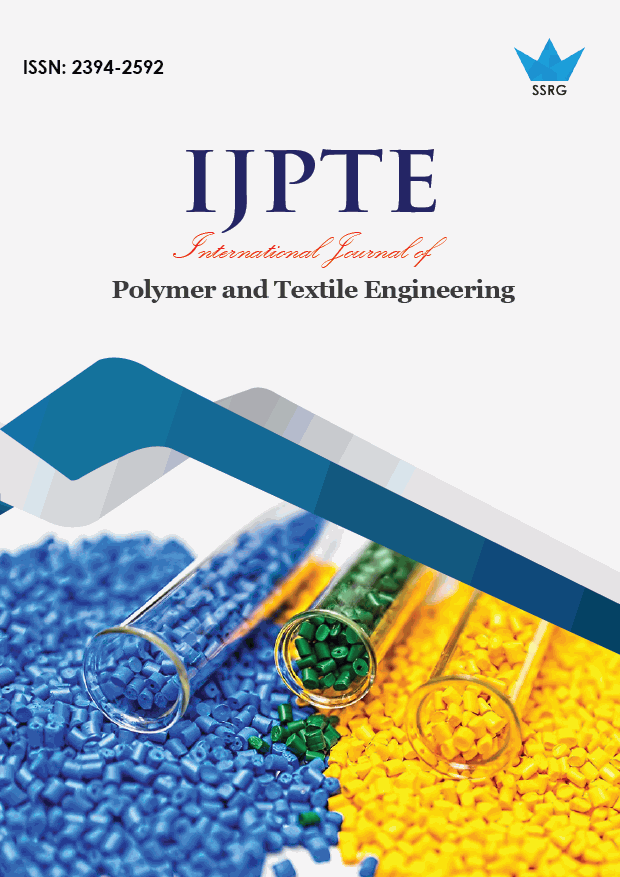Viscose Spun Yarn and Knitted Fabrics Properties Produced by Using Different Spinning Technologies

| International Journal of Polymer and Textile Engineering |
| © 2020 by SSRG - IJPTE Journal |
| Volume 7 Issue 3 |
| Year of Publication : 2020 |
| Authors : Muhammed Ali Karat, Osman Babaarslan |
How to Cite?
Muhammed Ali Karat, Osman Babaarslan, "Viscose Spun Yarn and Knitted Fabrics Properties Produced by Using Different Spinning Technologies," SSRG International Journal of Polymer and Textile Engineering, vol. 7, no. 3, pp. 1-11, 2020. Crossref, https://doi.org/10.14445/23942592/IJPTE-V7I3P101
Abstract:
In this study, using Ne 28/1 (21 tex) 100% viscose fiber, ring, compact, rotor, and vortex spinning systemsare used to examine the yarns and some selected properties of knitted fabrics from these yarns. Yarns produced using different spinning technologies were knitted into a fabric with a plain structure produced in two different yarn stitch densities (ring and compact are the same, rotor and vortex are the same). Then, the pilling abrasion (with ICI box and Martindale) of knitted fabrics produced using yarns from different spinning technologies and burst strength performance is examined. As a result, the yarn produced with the compact system in terms of yarn gave the best results of general properties. Fabrics were examined in two groups. It was observed that the fabrics knitted with compact yarns had better pilling properties than the fabrics knitted with ring yarns. However, the pilling performance of knitted fabric made from yarns produced by vortex technology is better than knitted fabric from OE rotor yarns.
Keywords:
Spinning Systems, Ring, Compact, OE Rotor, Vortex, Yarn Properties, Knitted Fabric, Pilling, Bursting Strength.
References:
[1] Al Samsam, A., Bakour, M., 2008. “Compare Between The Ring Spinning And The Open-End Spinning”, Textile Machine Department, Aleppo University, Aleppo, Syria, Pp. 7-11.
[2] Erdumlu, N., Ozipek, B., Oztuna, A., 2009. “Investigation Of Vortex Spun Yarn Properties In Comparison With Conventional Ring And Open-End Rotor Spun Yarns”, Textile Research Journal, 79, Pp. 585–595.
[3] Eldessouki, M., Ibrahim, S., Farag, R., 2014. “Dynamic Properties Of Air-Jet Yarns Compared To Rotor Spinning”, Textile Research Journal, 0(00) 1–11–, DOI:10.1177/0040517514563726.
[4] Nakib-Ul-Hasan, Md., Afroz, F., Mufidul, Islam M., Zahirul, Islam S.M., Hasan, R., 2014. “Comparative Study Of Mechanical Properties Hairiness And Evenness Of Conventional Ring And Modern Rotor Spun Yarn”, European Scientific Journal, Vol.10, No: 33, Issn 1857 – 7881, 2014, Pp. 212-219.
[5] Rameshkumar, C., Anandkumar, P., Senthilnathan, P., Jeevitha, R., Anbumani, N., 2008. “Comparative Studies On Ring Rotor And Vortex Yarn Knitted Fabrics”. AUTEX Research Journal, 8, Pp. 100–105.
[6] Frey, H. G., 2001. “The Future Belongs To Compact Spinning”, Melliand International, 7, Pp.16-17.
[7] Stalder, H., 2000. “New Spinning Process Comfor Spin”, Melliand International, 6, Pp. 22-25.
[8] Saad M.A., Almetwally A.A., 2008. Text Asia, 46 (7) 35.
[9] Klein, W., 1998. “Manual Of Textile Technology: Short-Staple Spinning Series”, The Technology of Short-staple Spinning, The textile institute, Manchester, vol. 1.
[10] Pei, Z., Zhang, Y., Chen, G., 2017. “A Core-Spun Yarn Containing A Metal Wire Manufactured By A Modified Vortex Spinning System”, Textile Research Journal, 0(00) 1–6, DOI:10.1177/0040517517736477.
[11] Basal, G., Oxenham, W., 2003. “Vortex Spun Yarn Vs. Air-Jet Spun Yarn”, AUTEX Research Journal, Vol. 3, No: 3, Pp. 96-101.
[12] Chidambaram, P., Govind, R., Venkataraman1, K.C., 2011. “The Effect Of Loop Length And Yarn Linear Density On The Thermal Properties Of Bamboo Knitted Fabric”, Department Of Fashion Technology, Sona College of Technology, India, AUTEX Research Journal, Vol. 11.
[13] Ivanova, L.V., Lotarev, B.M., Shimko, I.G., Lipinskii, S.P., Merzlyakova, V.I., Usenko, V.A., 1971. “Textured Viscose Rayon Filament Yarn Chemistry And Technology Of Natural-Polymer Fibres, Fiber Chemistry”, Vol. 3, No: 6, DOI:10.1007/BF00635781, Pp. 656-658.
[14] Mogilevskii, E.M., Shimko, I.G., Ivanova, L.V., Lipinskii, S.P., Merzlyakova, V.I., 1974. “Formation Of The Bulked Structure Of Textured Viscose Rayon”, Fiber Chemistry, Vol. 6, No: 6, Pp. 650-652.
[15] TS 244 EN ISO 2060, 13.04.1999 “Textiles-Yarn from packages-Determination of linear density (mass per unit length) by the skein method”.
[16] TS 247 EN ISO 2061: 1999 “Textiles - Determination of twist in yarns - Direct counting method”.
[17] TS 628 July 1970 “Yarn Unevenness Determination Methods”.
[18] TS 245 April 1988 “Breaking Strength of Single Yarn and Determination of Breaking Elongation.”
[19] TS 71218 EN ISO 5084. 1998. “Determination of thickness knitted fabric method.”
[20] TS EN 14971.2006, “Determination knitted fabric numbers of wales and courses”.
[21] TS EN 12127.1999, “Determination of knitted fabric wight method”.
[22] NF EN Iso 12945-1(2002) “Standard Test Method To Determination Of Fabric Propensity To Surface Fuzzing And To Pilling-Part 1: Pilling Box Method”. Muhammed Ali Karat et al. / IJPTE, 7(3), 1-11, 2020
[23] NF EN Iso 12945-2(2000) “Standard Test Method To Determination Of Fabric Propensity To Surface Fuzzing And To Pilling-Part 2: Modified Martindale Method”.
[24] NF EN Iso 13938-2(1999) “Standard Pneumatic Test Method For Determination Of Bursting Strength And Bursting Distension Of Fabrics”.
[25] NPTEL 2013, “New Spinning Systems” Vortex Spinning, Sen K., IIT Delhi, Viewed 17 April 2019.

 10.14445/23942592/IJPTE-V7I3P101
10.14445/23942592/IJPTE-V7I3P101